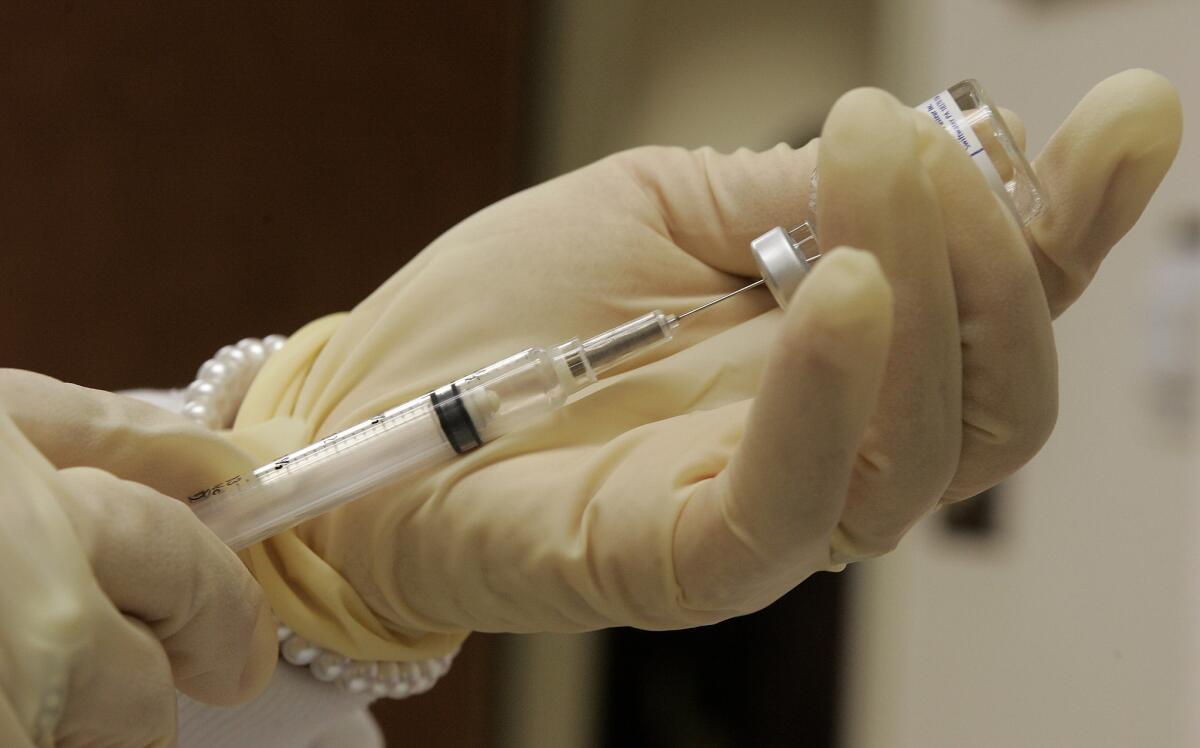Lawyers versus doctors in costly Prop. 46 campaign wars

SACRAMENTO â A ballot initiative that pits lawyers against doctors has set off one of this yearâs fiercest campaign wars, a costly clash over increasing state limits on malpractice damages and imposing drug testing on physicians.
Proposition 46 would raise the cap on pain-and-suffering awards in malpractice lawsuits and require that hospitals randomly test their doctors for drug and alcohol use. Backers say the measure would rein in negligent doctors; opponents charge that itâs a money grab by the lawyers who helped put it on the ballot.
Supporters have raised only a fraction of the money that opponents have collected for their side of the battle. But the âyesâ side is hoping that the attention-grabbing issue of drug testing can help surmount the cash disadvantage.
âWeâre ringing the alarm bell for the public that there are quacks that like their Jack and smack, and they hurt people,â said Jamie Court, president of the advocacy group Consumer Watchdog.
Opponents have built their campaign primarily around the proposalâs potential costs â and potential benefits for the other side.
Proposition 46âs âgreatest weak spot is its price tag,â said Jason Kinney, spokesman for the ânoâ campaign. âUnder Prop 46, trial lawyers stand to make a lot of money and everyone else is going to be stuck footing the bill.â
In wading into the complex world of healthcare spending, both sides have cherry-picked research and messages that best serve their causes.
The initiative would change Californiaâs decades-old $250,000 limit on the non-economic awards people can win in medical negligence cases. That cap dates to 1975, and supporters of the ballot measure say it has become economically unfeasible for lawyers to take many such cases.
The limit would rise to $1.1 million under Proposition 46 and would be indexed to inflation in the future.
One ad the ânoâ campaign has aired says the measure could cost state and local governments hundreds of millions of dollars annually. Thatâs the high end of an estimate by the nonpartisan Legislative Analystâs Office, which determined that higher malpractice insurance costs for doctors could be passed on to other purchasers, such as the government.
Those costs could range from the low tens of millions of dollars to several hundred million a year, the analysis said.
The ad also says overall total healthcare costs could increase by billions in a few years, raising expenses for an average family of four by more than $1,000 annually.
Those figures come from a study commissioned by supporters of damages caps, which found that healthcare spending would increase by 3.13% due to more âdefensive medicineâ â additional tests and procedures conducted to ward off lawsuits â if the award limit were raised.
Other studies suggest differently.
A Congressional Budget Office analysis estimated that defensive medicine accounted for 0.3% of national healthcare expenditures. And a Rand Corp. study of hospital emergency departments in three states with strict malpractice limits found the caps had little effect on the cost of care.
At a panel last week at Southwestern Law School, Dylan Roby, a UCLA health policy and management professor, said states that cap noneconomic damages have lower medical malpractice premiums than states without caps. The caps make no difference, however, in overall healthcare spending, he said.
Supporters say Proposition 46 would save money. Screening for impaired doctors, they argue, would curtail costly medical errors.
The drug-testing provision has been central in supportersâ ads. One commercial portrays a lab coat-clad doctor gulping drinks at a bar as his beeper pages him to the emergency room.
But because there is no other doctor drug-testing law in the country, thereâs no evidence that such a policy would decrease any costs, Roby said in a later interview.
A third element of Proposition 46 would require that physicians consult a state-run database of Californiansâ prescription histories involving certain drugs before prescribing those medications, to clamp down on patient âdoctor shoppingâ for addictive drugs.
That would reduce the volume of prescriptions for such drugs, proponents say, and thus the money that government-subsidized healthcare programs, for example, shell out for them.
The legislative analyst said savings from drug testing and database use were âuncertain, but potentially significant.â
Opponents have aired an ad that took aim at the database provision, saying Californiansâ prescription records could be vulnerable to hacking.
The database has been online since 2009 and has never suffered a breach âas far as weâre aware,â said Nick Pacilio, spokesman for the California Department of Justice.
Both camps have taken swipes at the otherâs financial support.
The ânoâ side has emphasized in nearly every commercial that Proposition 46 is championed by lawyers. Attorneys have contributed the vast majority of the âyesâ campaignâs $9-million intake, including a $1-million loan last week from the Consumer Attorneys of California, one of the measureâs primary backers.
Proponents have played up the heavy spending by the insurance industry against the measure. Nearly three-quarters of the opponentsâ $57-million war chest has come from six insurance companies.
Other big backers include the state medical and dental associations.
The opponentsâ money edge has enabled them to blanket television and radio airwaves throughout the state. Supporters have stuck with television in major markets.
Twitter: @melmason
More to Read
Sign up for Essential California
The most important California stories and recommendations in your inbox every morning.
You may occasionally receive promotional content from the Los Angeles Times.










